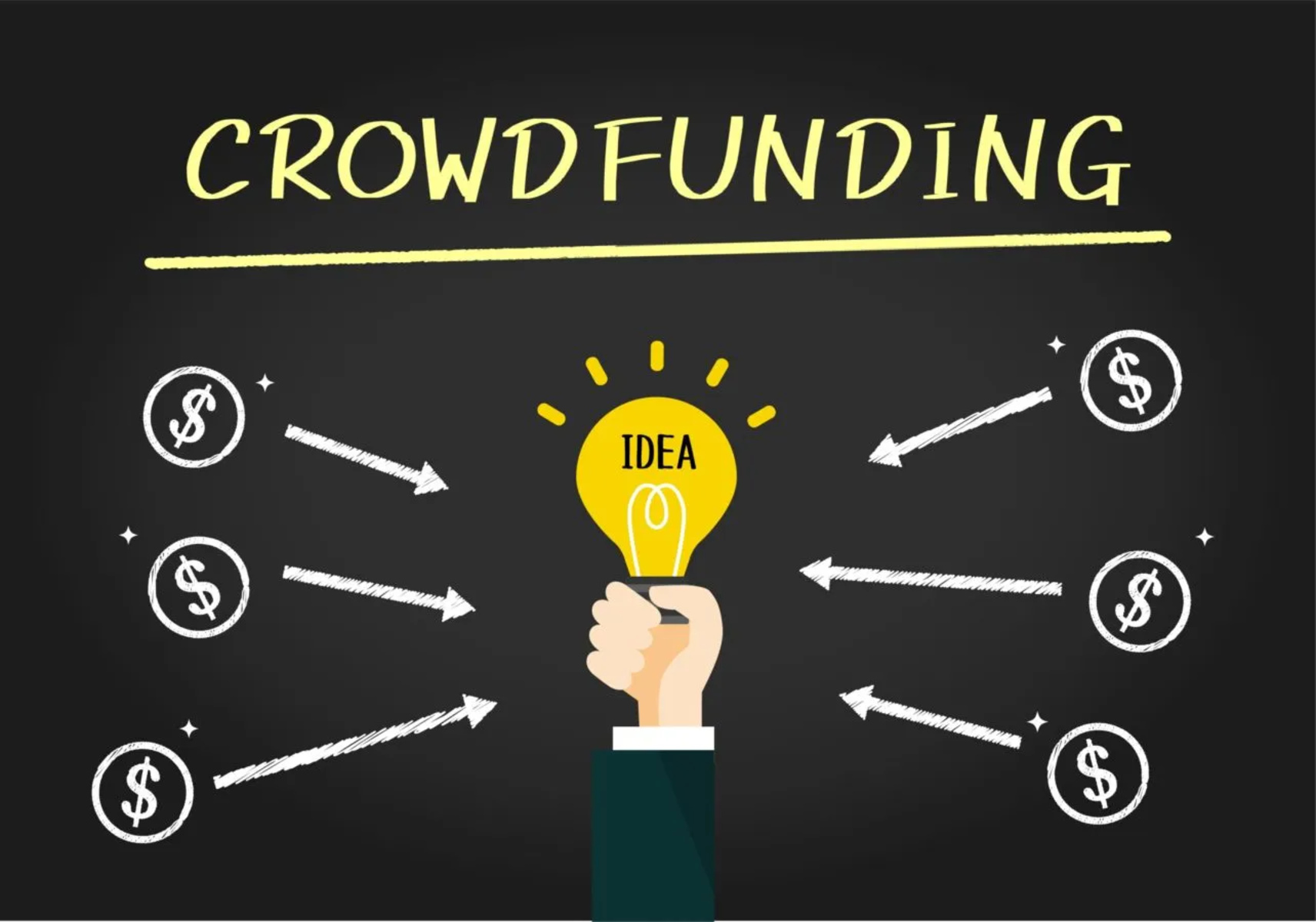Introduction
Welcome to the world of crowdfunding, a revolutionary way to fund your projects and ideas. Whether you’re an entrepreneur, a creative artist, a non-profit organization, or an individual with a passion project, crowdfunding offers a platform to raise the necessary funds from a community of supporters. This method has become increasingly popular in recent years, allowing individuals and businesses to bypass traditional financing channels and gain direct support from their target audience.
Understanding how to set up a successful crowdfunding campaign is crucial to your fundraising success. It involves strategic planning, effective communication, and a strong online presence. In this guide, we’ll explore the essential steps to help you kickstart your crowdfunding journey and achieve your funding goals.
First, let’s clarify what crowdfunding is. Simply put, crowdfunding is a way to collect funds from a large number of people, usually through an online platform. Instead of seeking funding from a single investor or institution, you can appeal to a broader audience who believes in your project or cause. This approach not only provides financial support but also generates a sense of community and engagement around your endeavor.
Choosing the right crowdfunding platform is crucial to the success of your campaign. Different platforms cater to various types of projects, industries, and target audiences. It’s important to research and compare different platforms to find the one that aligns with your project goals and resonates with your target audience.
Setting a funding goal is another critical aspect of your crowdfunding campaign. It’s essential to determine the amount of funding you need to bring your project to life. Your funding goal should be realistic, taking into account the costs of production, marketing, and any additional expenses. Be transparent about how the funds will be utilized to build trust with your supporters.
Creating a compelling and engaging crowdfunding campaign is key to attracting potential backers. Your campaign page should clearly communicate your project’s goals, mission, and why it matters. Utilize multimedia elements such as videos, high-quality images, and impactful storytelling to capture the attention and interest of your audience. Highlight the unique features and benefits of your project to differentiate yourself from the competition.
Understanding Crowdfunding
Crowdfunding is a financing method that allows individuals or businesses to raise money for a project or venture by collecting small contributions from a large number of people. It has gained traction as an alternative to traditional financing options and has revolutionized the way projects are funded.
One of the key advantages of crowdfunding is that it allows entrepreneurs and creatives to connect directly with their target audience. Instead of relying on banks or investors, crowdfunding platforms provide a space where individuals can pitch their ideas and campaigns to a community of potential backers. This democratized approach offers a level playing field for projects of all sizes and sectors.
There are different types of crowdfunding models, each with its own unique characteristics. The most common types include donation-based crowdfunding, reward-based crowdfunding, equity crowdfunding, and debt-based crowdfunding.
1. Donation-based crowdfunding: In this model, backers contribute funds to support a cause or a project without expecting anything in return. This type of crowdfunding is often used for charitable initiatives, social causes, or community projects.
2. Reward-based crowdfunding: In reward-based crowdfunding, project owners offer incentives or rewards in exchange for financial contributions. These rewards can range from exclusive merchandise, early access to the product, or personalized experiences related to the project.
3. Equity crowdfunding: Equity crowdfunding allows individuals to invest in a company in exchange for a share of ownership or equity. This model is commonly used by startups or small businesses looking to raise capital and offer investors the potential for financial returns.
4. Debt-based crowdfunding: Debt-based crowdfunding, also known as peer-to-peer lending or crowdlending, involves individuals lending money to borrowers in return for interest payments over a specified period. This model provides an alternative to traditional banks and allows borrowers to access funds without going through a financial institution.
Understanding the different crowdfunding models will help you choose the most suitable approach for your project or venture. It’s important to consider your goals, the nature of your project, and the expectations of your target audience when deciding on the crowdfunding model that aligns best with your needs.
Crowdfunding is not just about raising funds. It’s also an opportunity to build a community around your project and engage with potential supporters. By tapping into the power of social media and online platforms, you can expand your reach and connect with like-minded individuals who share your vision and are passionate about your project’s success.
In the next section, we’ll delve deeper into choosing the right crowdfunding platform for your campaign and how to effectively set a funding goal.
Choosing the Right Crowdfunding Platform
Choosing the right crowdfunding platform is a crucial step in launching a successful campaign. With so many options available, it’s important to consider several factors before making your decision.
1. Type of Project: Different crowdfunding platforms specialize in specific types of projects, such as creativity, technology, social causes, or entrepreneurship. Consider the nature of your project and find a platform that caters to your niche. The platform should have a track record of successfully funding projects similar to yours.
2. Platform Fees: Crowdfunding platforms typically charge fees for their services. These fees can include a percentage of the funds raised or a flat fee per transaction. Evaluate the fee structure of each platform and consider how it aligns with your fundraising goals. Keep in mind that higher fees may come with additional features or services that can benefit your campaign.
3. Reach and User Base: The size and reach of a crowdfunding platform’s user base are crucial factors in determining your campaign’s exposure. A platform with a large and active community increases the chances of your project being discovered by potential backers. Research the platform’s user base, their engagement levels, and the platform’s marketing and promotion efforts to ensure maximum visibility for your campaign.
4. Fundraising Model: Consider the type of crowdfunding model that best suits your project. Some platforms specialize in donation-based crowdfunding, while others focus on the reward-based, equity-based, or debt-based models. Ensure that the platform you choose supports the fundraising model you intend to use.
5. Platform Features: Evaluate the features and tools offered by each platform. Look for features that allow you to showcase your project effectively, communicate with backers, track campaign progress, and manage rewards. User-friendly interfaces and intuitive dashboards will make it easier for you to navigate the platform and manage your campaign efficiently.
6. Reputation and Trustworthiness: A reputable and trustworthy platform is essential for the success of your crowdfunding campaign. Read reviews, testimonials, and case studies of previous campaigns to gauge the platform’s reliability and track record. Look for platforms that prioritize security and provide support and guidance throughout the fundraising process.
7. Additional Services: Some crowdfunding platforms offer additional services, such as marketing support, campaign optimization, and post-campaign fulfillment assistance. Consider whether these services align with your needs and budget. While not essential, they can be valuable in maximizing the effectiveness of your campaign.
Take your time to research and compare different crowdfunding platforms. Consider seeking advice from other project owners who have utilized crowdfunding successfully. Remember that the platform you choose will play a significant role in your campaign’s success, so choose wisely.
Now that you have chosen the right crowdfunding platform for your project, the next step is to set a realistic funding goal. We will discuss this in the next section.
Setting a Funding Goal
Setting a funding goal is a crucial step in planning your crowdfunding campaign. Your funding goal should be realistic, calculated, and aligned with the scope of your project. It represents the amount of money you need to raise in order to bring your project to life.
1. Calculate Your Expenses: Start by carefully evaluating the costs associated with your project. Consider all the expenses you will incur, such as production costs, manufacturing, marketing, packaging, shipping, and any other overhead costs. It’s essential to have a clear understanding of how much money you need to cover these expenses.
2. Be Transparent: Transparency is crucial when setting your funding goal. Clearly communicate to your potential backers how the funds will be utilized and what they will contribute to. Break down the costs and explain how each component is essential for the success of your project. This transparency will build trust and confidence in your campaign.
3. Factor in Platform Fees and Taxes: Don’t forget to account for platform fees and taxes when setting your funding goal. Crowdfunding platforms typically charge fees for their services, and you will need to consider these fees as a part of your overall expenses. Additionally, you may need to allocate a portion of the funds for taxes and other financial obligations.
4. Consider Stretch Goals: Stretch goals are additional funding targets set beyond your initial funding goal. These goals allow you to provide enhanced features, additional rewards, or expanded project scope to your backers. Stretch goals can help create excitement and incentivize backers to continue supporting your campaign even after the initial funding goal has been reached.
5. Research Similar Projects: Look into successful campaigns within your niche or category to gain insights into their funding goals. Analyze campaigns that are similar in scope and ambition to yours and observe how they set their funding goals. While you don’t want to copy their exact figures, this research can provide a benchmark and help you set a realistic funding goal based on market standards.
6. Assess Your Network: Evaluate the size and engagement level of your existing network. Take into consideration the number of potential backers you can reach within your network, including family, friends, colleagues, and social media connections. This evaluation will help you gauge the realistic potential for generating initial support for your project.
Setting a realistic funding goal is crucial for the success of your crowdfunding campaign. A goal that is too high may discourage potential backers, while a goal that is too low may not adequately fund your project. Take the time to carefully calculate and consider all relevant factors before determining your funding goal.
In the next section, we’ll explore how to create an engaging crowdfunding campaign to attract and captivate your target audience.
Creating an Engaging Crowdfunding Campaign
Creating an engaging crowdfunding campaign is crucial to capturing the attention and support of potential backers. A well-crafted campaign can effectively convey your project’s mission, value, and why it matters to your target audience. Here are some key elements to consider when creating your campaign:
1. Compelling Storytelling: Use the power of storytelling to engage and connect with your audience on an emotional level. Share your project’s journey, the inspiration behind it, and the impact it can have. Craft a narrative that resonates with your target audience and inspires them to become part of your project’s story.
2. High-Quality Visuals: Visuals are a crucial aspect of your campaign. Use high-quality images, videos, or even animations to showcase your project. Visuals help bring your project to life and give potential backers a better understanding of what you’re trying to achieve. Make sure the visuals are clear, aesthetically pleasing, and align with the tone and message of your campaign.
3. Clear and Concise Description: Your campaign description should be clear, concise, and easy to understand. Clearly explain what your project is, what problem it solves, and what sets it apart. Use compelling language, bullet points, and subheadings to break up the text and make it easier for potential backers to scan and grasp the key details.
4. Set Achievable Milestones: Setting achievable milestones can help generate excitement and give backers a sense of progress. Break your project into smaller, tangible goals, and communicate how these milestones contribute to the overall success of your project. This also reassures backers that their support is making a meaningful impact.
5. Engage with Backers: Engaging with your backers is essential for building a strong and supportive community. Respond to comments, questions, and feedback in a timely manner. Show appreciation for their support by providing updates and acknowledging their contributions. This not only strengthens the bond with existing backers but also attracts new ones through positive word-of-mouth.
6. Showcase Rewards: Give careful thought to the rewards and incentives you offer for different funding levels. Make them appealing, exclusive, and aligned with the theme of your project. Offer a variety of reward options to cater to different preferences and budgets. Clearly communicate the value of each reward to entice potential backers.
7. Social Proof: Incorporate testimonials, endorsements, or reviews from individuals or influencers who have experienced or support your project. Social proof helps build trust and credibility, assuring potential backers that your project is legitimate and worth supporting.
8. Call to Action: End your campaign with a clear and compelling call to action. Encourage potential backers to support your project and share the campaign with their networks. Provide easy-to-use sharing buttons and pre-written social media messages to make it effortless for backers to spread the word about your campaign.
Remember, an engaging crowdfunding campaign is a combination of compelling storytelling, striking visuals, clear communication, and strong community engagement. Put yourself in the shoes of your potential backers and think about what would captivate and motivate them to contribute to your campaign.
In the next section, we’ll discuss how to plan an effective promotional strategy to maximize the reach and impact of your crowdfunding campaign.
Planning Your Promotional Strategy
Planning an effective promotional strategy is essential to maximize the reach and impact of your crowdfunding campaign. It involves creating awareness, generating buzz, and driving traffic to your campaign page. Here are key steps to consider when planning your promotional strategy:
1. Build a Pre-Launch Buzz: Start promoting your campaign even before it goes live. Build anticipation by sharing teasers, behind-the-scenes content, and snippets of your project. Leverage social media platforms, your website, and email newsletters to create a buzz and generate excitement among your existing network.
2. Engage Influencers and Supporters: Identify influencers, bloggers, or individuals with a following in your target audience. Reach out to them and offer a preview or exclusive access to your project. Collaborate with them to create content, host interviews, or share their endorsement of your campaign. Their support can significantly expand your campaign’s reach.
3. Leverage Social Media: Social media platforms provide a powerful way to connect with your target audience and spread the word about your campaign. Create engaging content, including images, videos, and infographics. Use relevant hashtags, tag influential accounts, and encourage your followers to share your campaign on their networks.
4. Email Marketing: Use your email list to communicate directly with your supporters and potential backers. Craft compelling and personalized emails to inform them about your campaign, its progress, and any updates or milestones. Provide clear calls to action and make it easy for them to support and share your campaign.
5. Collaborate with Media Outlets: Reach out to relevant media outlets, publications, or websites that cover topics related to your project. Pitch your campaign and offer them exclusive interviews, guest articles, or story angles. Getting featured in the media can expose your campaign to a broader audience and lend credibility to your project.
6. Utilize Online Communities: Join online communities and forums relevant to your project. Engage in discussions, share your expertise, and provide valuable insights. Be helpful and genuine in your interactions, and avoid being overly promotional. People will be more likely to support your campaign if they see you as a trusted member of the community.
7. Create Shareable Content: Develop content that is highly shareable and has the potential to go viral. This could include engaging videos, informative blog posts, or interactive quizzes related to your project. Encourage your supporters to share the content within their networks, helping to amplify your campaign’s reach.
8. Host Events or Webinars: Consider hosting live events or webinars to generate interest and engage with your audience directly. This could involve a Q&A session, a demo of your product, or a panel discussion related to your project. Use these opportunities to gather feedback, answer questions, and encourage attendees to support your campaign.
9. Maintain Momentum: Keep the momentum going throughout your campaign by consistently updating your supporters and engaging with potential backers. Share updates on your project’s progress, offer exclusive rewards or limited-time incentives, and remind people about the importance of their support. This helps drive a sense of urgency and encourages people to take action.
Remember, a well-planned and executed promotional strategy is crucial for the success of your crowdfunding campaign. Be proactive, creative, and persistent in your efforts to create awareness and generate support. In the next section, we’ll delve into crafting an effective pitch to captivate potential backers and encourage them to contribute to your campaign.
Crafting an Effective Pitch
Your pitch is the heart of your crowdfunding campaign. It’s the message that will captivate potential backers, convey the value of your project, and convince them to support your campaign. Here are key elements to consider when crafting an effective pitch:
1. Hook Your Audience: Start your pitch with a compelling and attention-grabbing hook. Capture your audience’s interest from the very beginning with a thought-provoking question, a bold statement, or an engaging story. This will entice them to continue reading or watching your pitch.
2. Clearly Explain Your Project: Provide a concise and clear explanation of your project. Clearly state what your project is, what problem it solves, and how it benefits your target audience. Use simple language and avoid jargon or technical terms that may confuse potential backers.
3. Showcase Your Passion and Expertise: Share your passion, dedication, and expertise in your project. Demonstrate your deep understanding of the problem you’re solving and how your unique perspective sets your project apart. This will instill trust and credibility in potential backers.
4. Highlight the Impact: Emphasize the impact that your project will make. Clearly communicate the positive change or improvement that your project will bring to the lives of your target audience or the community. Paint a vivid picture of the transformative effects of supporting your campaign.
5. Use Visuals and Multimedia: Incorporate visuals and multimedia elements to enhance your pitch. Use high-quality images, videos, infographics, or product demos to showcase your project in action. Visuals can make your pitch more engaging, memorable, and persuasive.
6. Outline the Budget and Funding Needs: Be transparent about your project’s budget and funding needs. Break down the costs and explain how the funds will be utilized. This level of transparency will build trust and instill confidence in potential backers that their contributions will be put to good use.
7. Clearly Define the Rewards: Clearly communicate the rewards and incentives that backers will receive for their support. Explain what each reward level entails, the value it provides, and how it enhances the overall project experience. Make the rewards appealing and aligned with your project’s theme to incentivize support.
8. Show Social Proof: Incorporate social proof in your pitch to build credibility. This can include testimonials, reviews, or endorsements from influencers or early supporters of your project. Social proof reassures potential backers that your project is trustworthy and worth supporting.
9. Include a Call-to-Action: End your pitch with a clear call-to-action. Clearly instruct potential backers on how they can support your campaign, whether it’s pledging a specific amount, sharing the campaign with their networks, or subscribing to updates. Make it easy for them to take action and support your project.
10. Keep it Concise: While it’s important to provide enough information, keep your pitch concise and to the point. Avoid overwhelming potential backers with too much text or information. Focus on presenting the most critical aspects of your project in a concise yet compelling manner.
Crafting an effective pitch requires a balance of clear communication, storytelling, visuals, and persuasion. Take the time to refine your pitch and seek feedback from trusted individuals before launching your campaign. With a compelling pitch, you can capture the attention and support of potential backers.
In the next section, we’ll discuss the importance of sharing your campaign on social media to expand your reach and attract more backers.
Sharing Your Campaign on Social Media
Social media has become a powerful tool for promoting and sharing your crowdfunding campaign. It provides a platform to reach a wide audience, engage with potential backers, and generate buzz around your project. Here are some key strategies for sharing your campaign effectively on social media:
1. Choose the Right Platforms: Identify the social media platforms that are most relevant to your target audience. Focus your efforts on platforms where your potential backers are active and engaged. This may include popular platforms like Facebook, Twitter, Instagram, LinkedIn, or niche platforms relevant to your project.
2. Create Engaging Content: Develop compelling and visually appealing content that captures the attention of your audience. Share high-quality images, videos, infographics, or behind-the-scenes content related to your project. Craft engaging captions or descriptions that effectively convey your project’s value and call to action.
3. Utilize Hashtags: Hashtags are a powerful tool for increasing the visibility and discoverability of your social media posts. Research and use relevant hashtags that are commonly used within your niche or industry. This will help attract the attention of individuals who are interested in projects similar to yours.
4. Leverage Influencers and Supporters: Collaborate with influencers, industry experts, or individuals with a large following who align with your project’s mission. Ask them to share your campaign on their social media platforms or provide testimonials. Their endorsement can greatly expand your reach and credibility.
5. Encourage Sharing and Engagement: Prompt your followers and supporters to share your campaign with their own networks. Ask them to spread the word and tag friends who might be interested in your project. Encourage engagement by responding to comments, answering questions, and fostering discussions related to your campaign.
6. Run Contests or Giveaways: Engage your audience by running contests or giveaways on social media. Offer exclusive rewards or experiences related to your project as prizes. This can help generate excitement, increase social media shares, and attract new potential backers.
7. Schedule Posts and Be Consistent: Consistency is key when it comes to social media. Create a content calendar and schedule posts in advance to ensure regular and consistent updates. Use social media management tools to help automate posting. This allows you to maintain a constant presence and reach your audience effectively.
8. Engage with Your Audience: Actively engage with your audience by responding to comments, direct messages, and mentions. Show appreciation for their support, answer their questions, and address any concerns they may have. Genuine interaction with your audience helps build trust and loyalty.
9. Utilize Paid Advertising: Consider allocating a budget for social media advertising to boost the visibility of your campaign. Platforms like Facebook and Instagram offer targeted advertising options that allow you to reach a specific audience based on demographics, interests, and behaviors. Use these tools strategically to expand your reach and target potential backers.
10. Track and Analyze Metrics: Monitor the performance of your social media efforts using analytics tools provided by each platform. Track metrics such as engagement rates, click-through rates, and conversions. Analyzing this data will help you understand what strategies are working effectively and allow you to make data-driven decisions for optimizing your social media campaigns.
Sharing your campaign on social media is a dynamic and ongoing process. Stay active, responsive, and creative in your approach. By utilizing the power of social media platforms, you can significantly increase the visibility of your campaign and attract more backers.
In the next section, we’ll discuss how to engage with potential backers effectively and increase the chances of their support for your crowdfunding campaign.
Engaging with Potential Backers
Engaging with potential backers is a crucial aspect of running a successful crowdfunding campaign. By actively engaging with your audience, you can build meaningful connections, address their questions or concerns, and cultivate a supportive community. Here are key strategies for effectively engaging with potential backers:
1. Respond Promptly: Be responsive and prompt in answering comments, direct messages, and emails from potential backers. Swift responses show that you value their input and are committed to providing a positive experience. Engaging in timely and genuine conversations helps build trust and encourages potential backers to support your campaign.
2. Personalize Your Interactions: Make your interactions with potential backers personal and tailored to their needs. Personalization can include addressing potential backers by their names, referencing specific questions or comments they’ve made, or acknowledging their previous support. This personalized approach helps create a sense of connection and makes potential backers feel valued.
3. Be Transparent: Transparency is essential for building trust with potential backers. Be transparent about your project’s progress, challenges, and any setbacks you may encounter. Share updates openly and honestly. This transparency helps potential backers feel involved and informed, and it fosters a sense of authenticity and credibility.
4. Show Appreciation: Express gratitude and appreciation to potential backers for their interest and support. Thank them for their comments, shares, or any other form of engagement. Regularly acknowledge and publicly recognize the contributions of your backers, ensuring they feel valued and appreciated. This practice encourages a positive relationship between you and potential backers.
5. Offer Incentives for Engagement: Encourage potential backers to engage with your campaign by offering incentives for their participation. This could include exclusive access to behind-the-scenes updates, sneak peeks, or the opportunity to provide feedback on certain aspects of the project. Incentives for engagement create a sense of exclusivity, making potential backers feel more invested in your campaign.
6. Share User-Generated Content: Encourage your followers and potential backers to create and share content related to your project. User-generated content can include testimonials, reviews, photos, or videos of them interacting with your campaign. This content not only serves as social proof but also reinforces the sense of community and involvement around your project.
7. Conduct Live Q&A Sessions: Host live Q&A sessions on social media platforms or through video streaming to directly engage with potential backers. These sessions allow you to address their questions, provide clarity, and share more about your project. Live interactions make potential backers feel heard and connected to your campaign.
8. Share Project Updates and Milestones: Regularly share updates on your project’s progress, especially when you hit key milestones. Celebrate the achievements and share the impact the project is making. By keeping potential backers informed about the project’s development, you foster a sense of excitement and demonstrate your commitment to delivering on your promises.
9. Foster a Sense of Community: Create a community around your project by encouraging interactions between potential backers. Facilitate discussions, encourage them to share their thoughts or experiences related to your project, and create a space where they can connect with one another. A strong sense of community increases engagement, loyalty, and overall support for your campaign.
10. Stay Active After the Campaign: Engage with backers even after the campaign ends. Keep them updated on the progress of your project, and involve them in the fulfillment process. Make them feel like they are part of the project’s journey even after the crowdfunding campaign concludes. By maintaining an ongoing connection, you can turn backers into long-term advocates for your brand or future projects.
Engaging with potential backers requires active participation, genuine communication, and a focus on building relationships. By fostering engagement, you can cultivate a supportive community that will not only contribute to your current campaign but also potentially become long-term supporters of your endeavors.
In the next section, we’ll discuss the importance of offering rewards and incentives for your crowdfunding campaign and how to create enticing offerings.
Offering Rewards and Incentives
Offering rewards and incentives is a powerful strategy to attract and motivate backers for your crowdfunding campaign. Rewards provide a way to show appreciation to your supporters and give them an additional incentive to contribute to your project. Here are key considerations when offering rewards and incentives:
1. Tailor to Backer Levels: Create reward tiers or levels that cater to different levels of support. Offer a range of options at varying price points to accommodate different budgets. Having multiple tiers allows backers to choose the level that best aligns with their preferences and desired involvement in your project.
2. Make Them Relevant: Ensure that your rewards are relevant and closely tied to your project. Align the rewards with the theme, purpose, or industry of your campaign. This creates a sense of coherence and helps backers see the direct value and connection between their contribution and the project.
3. Offer Exclusive Access: Provide exclusive access or early-bird rewards to backers who support your project during the early stages of your campaign. This creates a sense of exclusivity and encourages people to pledge their support sooner rather than later. Exclusive access can include things like limited edition merchandise, behind-the-scenes content, or the opportunity to provide feedback on the project.
4. Personalize the Experience: Consider offering personalized experiences or rewards that make backers feel special and appreciated. This could include personalized thank-you notes, customized merchandise, or even one-on-one interactions with you or your team. Personalization enhances the emotional connection between backers and your project.
5. Set Realistic and Attainable Goals: Ensure that your reward offerings are realistic and within your capacity to fulfill. Consider the costs, time, and resources required to deliver the promised rewards. It’s important to set attainable goals and deliver on your promises to maintain the trust and satisfaction of your backers.
6. Provide Value for Different Backer Levels: Make sure each reward tier provides value and incentives for backers to support at that specific level. Offer higher-value rewards for larger contributions, such as exclusive merchandise, VIP experiences, or special recognition. Backers should feel that they are receiving something worthwhile in exchange for their support.
7. Communicate the Benefits: Clearly communicate the benefits of each reward tier. Highlight the unique features, value, and exclusivity that backers will receive by supporting at a particular level. Help potential backers understand why each reward tier is compelling and worth their investment.
8. Update Backers on Fulfillment: Keep your backers informed about the fulfillment process regularly. Provide updates on the status and progress of reward production and delivery. Transparency and regular communication help build trust and ensure that your backers feel involved and valued throughout the process.
9. Consider Stretch Goals: Incorporate stretch goals into your campaign to motivate additional contributions and provide extra value to your backers. When stretch goals are reached, offer new rewards or enhancements to existing rewards. This creates a sense of excitement and encourages backers to continue spreading the word about your campaign.
10. Express Gratitude: Above all, express genuine gratitude and appreciation for your backers’ support. Thank them publicly through social media updates or campaign updates. Show that their contribution is highly valued and has a direct impact on the success of your project. A simple thank-you can go a long way in fostering positive relationships with your backers.
Offering well-planned rewards and incentives can significantly enhance the attractiveness of your crowdfunding campaign. It incentivizes potential backers to support your project, increases engagement, and helps cultivate a loyal community around your endeavor. By carefully considering and delivering on your reward offerings, you can inspire backers to contribute and promote your campaign to a wider audience.
In the next section, we’ll discuss the importance of tracking and analyzing your campaign’s progress to make data-driven decisions and optimize its performance.
Tracking and Analyzing Your Campaign’s Progress
Tracking and analyzing your campaign’s progress is crucial for making data-driven decisions and optimizing its performance. By monitoring key metrics and analyzing the data, you can gain valuable insights into the effectiveness of your strategies and make necessary adjustments to maximize your campaign’s success. Here are key steps for tracking and analyzing your campaign:
1. Set Measurable Goals: Start by setting specific and measurable goals for your campaign. These goals could include the amount of funds you aim to raise, the number of backers you want to attract, or the engagement rates you expect to achieve on social media. Clear goals allow you to track your progress and measure the success of your campaign.
2. Monitor Key Metrics: Identify the key metrics that are most relevant to your campaign. These may include total funds raised, the number of backers, average pledge amount, conversion rates, engagement rates on social media, or website traffic. Regularly monitor these metrics throughout your campaign to understand how it is performing.
3. Utilize Analytics Tools: Take advantage of analytics tools provided by crowdfunding platforms, social media platforms, or other tracking software. These tools can provide you with in-depth data and insights into various aspects of your campaign, such as visitor demographics, source of traffic, engagement levels, and conversion rates. Use this information to evaluate the effectiveness of your strategies and identify areas for improvement.
4. Track Conversion Funnel: Understand the journey that potential backers take from discovering your campaign to making a pledge. Track the conversion funnel to identify any conversion bottlenecks or areas where potential backers drop off. This allows you to optimize those stages and improve the overall conversion rate of your campaign.
5. A/B Testing: Conduct A/B testing to compare the performance of different elements of your campaign, such as headlines, visuals, or calls to action. By testing variations and analyzing the results, you can identify the most effective strategies and make data-driven decisions to optimize your campaign’s performance.
6. Evaluate Referral Sources: Identify and analyze the different sources of traffic and referrals to your campaign. This includes tracking the effectiveness of social media channels, email marketing campaigns, influencers, or any other promotional efforts. This analysis helps you understand which channels are driving the most traffic and conversions, allowing you to allocate resources accordingly.
7. Collect and Act on Feedback: Encourage backers and potential backers to provide feedback on your campaign. This can be done through surveys, comments, or direct messages. Collect and analyze this feedback to gain insights into what is resonating with your audience and what can be improved. Use this feedback to make adjustments and enhance your campaign strategy.
8. Regularly Update Backers: Keep your backers informed about the progress of your campaign through regular updates. Provide them with meaningful and relevant information about milestones achieved, new developments, or any challenges faced. This transparency not only engages your current backers but also builds trust and attracts potential backers.
9. Benchmark Against Similar Campaigns: Research and benchmark your campaign against similar campaigns within your niche or industry. Analyze the strategies and tactics they employed and evaluate their success. This benchmarking helps you identify opportunities for improvement and implement best practices that have proven effective in similar campaigns.
10. Adapt and Iterate: Based on the insights and data you gather, adapt and iterate your campaign as needed. Optimize your messaging, adjust your promotional strategies, or fine-tune your reward offerings. Continuous improvement and adaptation based on data analysis will increase the chances of achieving your campaign goals.
Tracking and analyzing your campaign’s progress empowers you to make data-informed decisions, refine your strategies, and optimize your campaign’s performance. Regularly review the metrics, experiment with different tactics, and act on the insights gained to ensure the success of your crowdfunding campaign.
In the next section, we’ll discuss the importance of creating a timeline for your campaign and managing backer expectations.
Creating a Timeline for Your Campaign
Creating a timeline for your crowdfunding campaign is essential for effective planning, organization, and successful execution. It serves as a roadmap that outlines the key milestones, tasks, and deadlines throughout your campaign. Here are key steps to consider when creating a timeline:
1. Set a Start and End Date: Determine the duration of your campaign by setting a clear start and end date. This timeframe should strike a balance between giving yourself enough time to promote and execute your campaign and creating a sense of urgency to encourage backers to take action.
2. Break Down Your Campaign into Phases: Divide your campaign into distinct phases or stages. This could include pre-launch preparations, the active fundraising period, and the post-campaign fulfillment phase. Each phase will require different activities and tasks, so breaking them down will help you allocate time and resources accordingly.
3. Set Milestones and Goals: Identify specific milestones and goals that you want to achieve throughout your campaign. These milestones can be related to the amount of funds raised, the number of backers gained, or the attainment of stretch goals. Setting milestones provides tangible targets to work towards and helps maintain momentum throughout your campaign.
4. Define Task Deadlines: Assign deadlines to each task or activity that needs to be completed as part of your campaign. This includes tasks such as creating content, developing promotional materials, reaching out to influencers, or sending out updates to backers. Having clear deadlines helps ensure that tasks are completed on time and keeps the campaign on track.
5. Allocate Time for Pre-Launch Preparation: Dedicate a portion of your timeline to pre-launch preparation. This includes activities such as building your campaign page, creating compelling content, finalizing reward offerings, and developing a promotional strategy. Preparing adequately before the campaign launch sets a strong foundation for success.
6. Promote Intensively During Active Fundraising Period: Allocate a significant portion of time and effort to promote your campaign during the active fundraising period. This includes engaging with potential backers, sharing updates on social media, responding to comments and inquiries, and reaching out to media outlets or influencers. Intensive promotion during this phase helps generate momentum and attract backers.
7. Account for Post-Campaign Fulfillment: Don’t forget to consider the time required for post-campaign fulfillment. This includes activities such as ordering and manufacturing rewards, organizing logistics for shipping, and managing communication with backers. Allocating sufficient time for fulfillment ensures a seamless and positive experience for your supporters.
8. Allow Flexibility: While it’s important to have a timeline, allow some flexibility to adapt to unforeseen circumstances, challenges, or opportunities that may arise during your campaign. Build in buffer time for unexpected delays or additional tasks that may come up during the course of your campaign.
9. Communicate the Timeline to Your Team: If you’re working with a team or have collaborators involved in your campaign, ensure that the timeline is communicated clearly to everyone. This helps keep everyone aligned with the expectations, deadlines, and tasks related to the campaign.
10. Regularly Evaluate and Update the Timeline: Continuously monitor the progress of your campaign and assess whether the timeline needs to be adjusted. Regularly evaluate if you’re on track to meet your goals and milestones. Adapt and update the timeline as necessary to ensure an efficient and successful campaign.
A well-structured timeline provides a roadmap for executing your crowdfunding campaign effectively. It allows you to plan, organize, and allocate resources efficiently, ensuring that you stay on track and meet your campaign goals within the designated timeframe.
In the next section, we’ll discuss the importance of managing backer expectations and fostering strong relationships with your supporters.
Managing Backer Expectations
Managing backer expectations is crucial for building trust, fostering positive relationships, and ensuring a successful crowdfunding campaign. Clear and transparent communication plays a key role in managing expectations and keeping your backers informed. Here are important considerations for effectively managing backer expectations:
1. Be Transparent from the Start: Set clear expectations from the beginning of your campaign. Clearly communicate the goals, scope, and timeline of your project. Discuss any potential risks or challenges that may arise during the process. Transparency builds trust and establishes a foundation of open communication.
2. Clearly Communicate Reward Fulfillment: Provide clear and detailed information about the fulfillment process for your rewards. Clearly state the estimated delivery timeline and any factors that may affect the timeline, such as manufacturing or shipping delays. Regularly update your backers on the progress of reward production and delivery, ensuring they’re informed every step of the way.
3. Address Backer Inquiries Promptly: Be responsive and prompt in addressing backer inquiries or concerns. Respond to emails, messages, and comments in a timely manner. Acknowledge their questions, provide helpful information, and offer reassurance when needed. This proactive approach helps build trust and demonstrates your commitment to meeting their expectations.
4. Communicate Challenges or Roadblocks: In the event of any challenges or roadblocks that may impact your project’s timeline or delivery, be open and honest with your backers. Communicate the issues clearly, explain the steps you’re taking to resolve them, and provide a revised timeline if necessary. Transparency during difficult times helps maintain backers’ understanding and support.
5. Provide Regular Updates: Keep your backers informed about the progress of your campaign through regular updates. Share milestones achieved, challenges faced, and any changes or adjustments made to the project. Regular updates build a sense of involvement and connection with your backers, ensuring they remain engaged and informed about the campaign’s progress.
6. Overcommunicate, but Don’t Overpromise: Strive to overcommunicate by providing frequent updates and responding to inquiries, but avoid overpromising. Be realistic about what you can achieve and deliver within the given timeline and resources. Setting realistic expectations ensures a smoother campaign experience and avoids disappointment for your backers.
7. Showcase Testimonials or Backer Stories: Share testimonials or stories from satisfied backers to reinforce positive experiences. Highlight the impact your project has made on their lives or the benefits they have received from supporting your campaign. Sharing these stories helps enforce the value and fulfillment backers can expect from your project.
8. Offer Exceptional Customer Support: Prioritize excellent customer support by providing multiple channels for backers to reach out to you. Respond to inquiries promptly and with empathy. Demonstrate your commitment to providing exceptional support throughout the entire campaign journey.
9. Be Proactive with Updates and Changes: If you need to make changes or updates to your project or its timeline, be proactive in communicating these changes. Notify your backers in a timely manner, explaining the reasons behind the changes and any measures you’re taking to mitigate the impact. Address any concerns or questions that may arise as a result of the changes.
10. Express Gratitude and Appreciation: Continually express gratitude and appreciation to your backers for their support. Regularly thank them publicly through updates, social media posts, or personalized messages. Showcasing your appreciation reinforces the bond between you and your backers and helps foster long-term relationships.
Managing backer expectations is paramount for building trust, maintaining support, and ensuring a positive crowdfunding experience. By communicating clearly, providing updates, and addressing concerns promptly, you can create a community of loyal backers who feel valued and engaged.
In the next section, we’ll discuss the steps and considerations for ending your crowdfunding campaign successfully.
Ending Your Crowdfunding Campaign Successfully
Ending a crowdfunding campaign successfully involves more than just reaching your funding goal. It requires proper planning, clear communication, and effective follow-up. Here are key steps and considerations for ending your crowdfunding campaign on a positive note:
1. Celebrate and Express Gratitude: Once your campaign reaches its end, take the time to celebrate your achievements and express gratitude to your backers. Share a final update that highlights the impact of their support and how it will contribute to the success of your project. Show genuine appreciation for their trust and investment in your vision.
2. Fulfill Rewards Promptly: Begin the process of fulfilling rewards promptly after your campaign ends. Stay in touch with your backers and provide regular updates on the progress of reward production, shipping, and delivery. Aim to deliver rewards within the estimated timeframe communicated during the campaign. This ensures that your backers receive their rewards in a timely manner and maintains their satisfaction.
3. Communicate Post-Campaign Plans: Keep your backers informed about what happens after the campaign. Share your plans for moving forward with project development or next steps. This demonstrates continued transparency and helps backers understand how their support is contributing to the realization of your project.
4. Remain Active on Social Media: Continue to engage with your backers and followers on social media even after the campaign ends. Share updates about your project’s progress, milestones achieved, or any new developments. Maintain active communication to keep your backers involved and excited about the journey ahead.
5. Provide Post-Campaign Updates: Regularly update your backers on the progress of your project in the post-campaign phase, even if there are no major milestones to report. This shows ongoing dedication and transparency, keeping backers informed and engaged throughout the project’s development.
6. Address Any Issues or Delays: If there are any unexpected issues or delays in project development, promptly communicate these challenges to your backers. Be transparent about the reasons behind the delays and the steps you’re taking to overcome them. Addressing issues openly and honestly helps maintain trust and keeps backers informed about the project’s progress.
7. Maintain Communication Channels: Keep communication channels open for backers to reach out with questions or concerns post-campaign. Respond to their inquiries promptly and continue providing excellent customer support. This level of attentiveness fosters strong relationships with your backers and shows your commitment to delivering a positive experience.
8. Update Backers on Project Milestones: Share updates with your backers whenever significant project milestones are achieved. This could include milestones such as product design completion, production start, or securing partnerships. Celebrate these milestones alongside your supporters and showcase the progress being made.
9. Provide Backer Recognition: Show appreciation to your backers by providing public recognition for their support. Feature their names or usernames on your website, in newsletters, or on social media. Acknowledging their contribution publicly reinforces their belief in the project and cultivates a sense of pride among your backers.
10. Encourage Ongoing Engagement: Continue to foster engagement with your backers beyond the campaign. Encourage them to share their experiences, provide feedback, or participate in surveys related to the project. Facilitate ongoing community interaction, as this can lead to valuable insights, continued support, and potential advocacy for your project.
Ending your crowdfunding campaign successfully involves more than just finalizing the fundraising aspect. It’s about maintaining strong relationships with your backers, delivering on your promises, and keeping them engaged throughout the entire project journey. By following these steps and considerations, you can end your campaign on a positive note and set the foundation for future success.
In the next section, we’ll wrap up this guide and provide a summary of the key points covered in the article.
Conclusion
Congratulations on reaching the end of this guide on how to set up a successful crowdfunding campaign. We’ve covered a wide range of topics, from understanding crowdfunding and choosing the right platform, to creating an engaging campaign, promoting it on social media, and managing backer expectations. Here’s a quick recap of the key points discussed:
– Crowdfunding is a powerful method to raise funds and connect with a supportive community of backers who believe in your project.
– Choosing the right crowdfunding platform is crucial, considering factors like the type of project, platform fees, reach, and additional services offered.
– Crafting an engaging campaign involves compelling storytelling, high-quality visuals, clear communication, and personalized interactions.
– Promoting your campaign on social media requires selecting the right platforms, creating engaging content, leveraging influencers, and encouraging sharing and engagement.
– Managing backer expectations involves transparency, clear communication, addressing inquiries promptly, and providing regular updates throughout the campaign and post-campaign phase.
– Offering appealing rewards and incentives is crucial to attract and motivate backers, while fulfilling rewards promptly and maintaining ongoing engagement is key to backer satisfaction.
– Tracking and analyzing your campaign’s progress allows you to make data-driven decisions, optimize strategies, and ensure success.
– Creating a timeline helps with planning, setting milestones, managing tasks, and delivering on your commitments.
– Ending your campaign successfully involves celebrating achievements, fulfilling rewards, communicating post-campaign plans, and continuing engagement with your backers.
Remember, a successful crowdfunding campaign requires careful planning, effective communication, and continuous engagement with your backers. Maintain transparency, stay proactive, and prioritize building strong relationships with your supporters. With a well-executed campaign, you can not only achieve your fundraising goals but also build a loyal community that supports your project long-term.
Good luck with your crowdfunding journey!

























